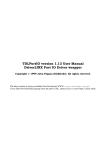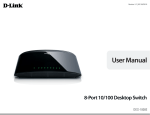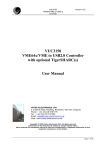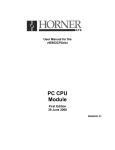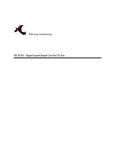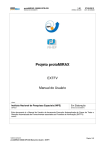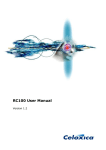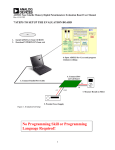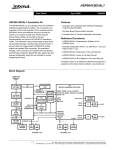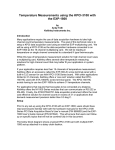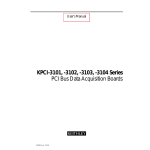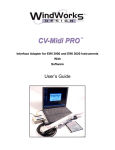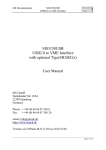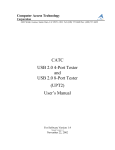Download TDLPortIO User Manual
Transcript
TDLPortIO version 1.2 User Manual DriverLINX Port IO Driver wrapper Copyright © 1999 John Pappas (DiskDude). All rights reserved. The latest version is always available from the Internet WWW: http://diskdude.cjb.net/ If you didn't download this package from the above URL, chances are it is out-of-date. Check often! TDLPortIO Documentation Page 2 © John Pappas (DiskDude) IMPORTANT! You should carefully read the license terms and conditions in Section 1.0 before using this software. Your use of this software indicates your acceptance of the license agreement and warranty. Table of Contents 1.0 LICENSE AGREEMENT..........................................................................................................................................3 1.1 FREEWARE ...............................................................................................................................................................3 1.2 DISTRIBUTION ...........................................................................................................................................................3 1.3 LEGAL DISCLAIMER ..................................................................................................................................................3 2.0 INTRODUCTION.......................................................................................................................................................4 2.1 WHAT IS THE DRIVERLINX PORT IO DRIVER? ........................................................................................................4 2.2 WHAT DOES TDLPORTIO DO? .................................................................................................................................4 2.3 WHAT IS TDLPORTIO COMPATIBLE WITH? ..............................................................................................................5 3.0 INSTALLING TDLPORTIO.....................................................................................................................................6 3.1 PORT IO ACCESS UNDER WINDOWS ..........................................................................................................................6 3.2 AUTOMATICALLY INSTALLING THE DRIVERLINX DRIVER .......................................................................................7 3.3 MANUALLY INSTALLING THE DRIVERLINX DRIVER ................................................................................................8 3.4 INSTALLING THE C++ BUILDER COMPONENT ...........................................................................................................9 3.5 INSTALLING THE DELPHI COMPONENT ......................................................................................................................9 3.6 INSTALLING THE ACTIVEX (OCX) COMPONENT .......................................................................................................9 3.7 INSTALLING THE ACTIVEX (OCX) COMPONENT INTO VISUAL BASIC ...................................................................10 4.0 USING TDLPORTIO...............................................................................................................................................11 4.1 AS A C++ BUILDER, DELPHI AND ACTIVEX COMPONENT ......................................................................................11 4.1.1 TDLPortIO Methods.......................................................................................................................................11 4.1.2 TDLPortIO Properties ...................................................................................................................................12 4.1.3 TDLPrinterPortIO Methods ...........................................................................................................................13 4.1.4 TDLPrinterPortIO Properties ........................................................................................................................13 4.2 AS A DLL ...............................................................................................................................................................14 5.0 BUGS, TO DO LIST, AND VERSION HISTORY................................................................................................15 5.1 FOUND A BUG? CHANGED THE SOURCE?.................................................................................................................15 5.2 TO DO LIST .............................................................................................................................................................15 5.2 VERSION HISTORY ..................................................................................................................................................16 6.0 CONTACTING THE AUTHOR .............................................................................................................................19 7.0 THANKS! ..................................................................................................................................................................19 8.0 TRADEMARKS........................................................................................................................................................19 TDLPortIO Documentation Page 3 © John Pappas (DiskDude) 1.0 License Agreement You should carefully read the following terms and conditions before using this software. Your use of this software indicates your acceptance of this license agreement and warranty. This license agreement does not cover the free DriverLINX driver provided by Scientific Software Tools (SST) Inc. All files distributed in this package, excepting those under the \DriverLINX tree, are covered by this agreement. Please refer to the SST agreement for the DriverLINX driver in the file \DriverLINX\License.txt 1.1 FreeWare You may use a FreeWare Copy of this Software for life. If you find it useful, an email to the author telling him what you used it for would be nice, but not necessary. Your email address will not be given to any other party, nor will it be sold or used for profit or commercial purposes. See Section 6.0 for information on how to contact the author. 1.2 Distribution You are hereby granted the right • • • • to make as many copies of this software and its documentation as you wish; give exact copies (including all files) of the original version to anyone; distribute the software and documentation in its unmodified form via electronic means; and distribute run-time files (TDLPortIO.dll, DLPortIOX.ocx, DLPortIO.bpl, DLPortIO.dpl) as part of your application without any royalties. There is no charge for any of the above. You are specifically prohibited from charging, or requesting donations, for any such copies (a small handling fee is acceptable). You are further prohibited from distributing the software and/or documentation with other products (commercial or otherwise) without prior written permission, excluding the run-time files as described above. This is so the author can keep track of where this package is distributed. 1.3 Legal Disclaimer THIS SOFTWARE IS PROVIDED "AS IS" WITHOUT WARRANTY OF ANY KIND, EITHER EXPRESSED OR IMPLIED, INCLUDING, BUT NOT LIMITED TO, THE IMPLIED WARRANTIES OF MERCHANTABILITY AND FITNESS FOR A PARTICULAR PURPOSE. THE ENTIRE RISK AS TO THE QUALITY AND PERFORMANCE OF THE SOFTWARE IS WITH YOU. SHOULD THE SOFTWARE PROVE DEFECTIVE, YOU ASSUME THE COST OF ALL NECESSARY SERVICING, REPAIR OR CORRECTION. IN NO EVENT WILL THE AUTHOR OR ANY OTHER PARTY WHO MAY HAVE DISTRIBUTED THE SOFTWARE AS PERMITTED ABOVE, BE LIABLE TO YOU FOR DAMAGES, INCLUDING ANY GENERAL, SPECIAL, INCIDENTAL OR CONSEQUENTIAL DAMAGES ARISING OUT OF THE USE OR INABILITY TO USE THE SOFTWARE (INCLUDING BUT NOT LIMITED TO LOSS OF DATA OR DATA BEING RENDERED INACCURATE OR LOSSES SUSTAINED BY YOU OR THIRD PARTIES OR A FAILURE OF THE SOFTWARE TO OPERATE WITH ANY OTHER PROGRAMS), EVEN IF SUCH HOLDER OR OTHER PARTY HAS BEEN ADVISED OF THE POSSIBILITY OF SUCH DAMAGES. TDLPortIO Documentation Page 4 © John Pappas (DiskDude) 2.0 Introduction 2.1 What is the DriverLINX Port IO Driver? The DriverLINX Port IO Driver allows you to use general port IO under Windows 95/98/NT. It does this by using in and out assembler instructions under Windows 95/98 (a guess, since there is no VxD), and through a kernel mode driver in Windows NT. It allows port read/writes of bytes, 16 and 32 bit words, as well as block read/writes of all ports from 100h to FFFFh. The DriverLINX driver is provided freely, without support, by Scientific Software Tools (SST), Inc. The author of TDLPortIO has no relation to SST, nor did he write the DriverLINX driver. You can download the original DriverLINX driver package from the URLs below. Included in this package is exactly what is distributed by SST, excluding the MSVC and Visual BASIC demo code/examples which push the file to 1.5Mbytes (along with InstallShield), compared to the 57kbytes for the DLL, kernel driver (.SYS) and API information included with this package in the directory tree \DriverLINX. Strictly speaking, it is not allowed to distribute the DriverLINX driver package other than as a whole, but the original package is too big. I have nothing to gain by not providing the original package and have provided ample opportunity for others to download it, from the URLs below. SST probably require that their package be distributed as a whole so their work is recognised, perhaps also why they request that their copyright messages are not to be removed. I believe that their work has been acknowledged sufficiently in this package for there not to be a problem. No copyright information has been removed from the DriverLINX driver files. DriverLINX URL: http://www.sstnet.com/ftp/unsupported/port95nt.exe ftp://ftp.sstnet.com/pub/unsupported/port95nt.exe My Backup URL: http://diskdude.cjb.net/files/cbuilder/DLPortIO/port95nt.exe 2.2 What does TDLPortIO do? TDLPortIO is an advanced wrapper. It provides a nice interface to the DriverLINX Port IO Driver. It will automatically handle the installation and operation of the DriverLINX Windows NT kernel mode driver (Windows NT accounts with administrator privileges only – see Section 3.1), and provides an intuitive interface to your program, like using the Port[] array for reading and writing ports (except ActiveX and DLL versions which require the use of functions; not indexed arrays). TDLPortIO Documentation Page 5 © John Pappas (DiskDude) 2.3 What is TDLPortIO compatible with? An attempt was made to make TDLPortIO compatible with the shareware Win95/NT Port IO package TVicPort. In addition to this, some extensions and improvements were made on their design. New features include: • • Burst read/write of a PortRec like array to include a mixture of Word and DWords Block read/write of Word and DWord buffers TDLPortIO is limited to what the DriverLINX driver provides, and hence cannot be 100% compatible with TVicPort, as in the following example: Hard/Soft access is not available, although the hardaccess property is present for code written for TVicPort – it simply have no effect. I assume DriverLINX uses the “hard access” by default, which cannot be changed. That is, it does not ask the operating system politely before accessing a port, to avoid collisions with some other driver/program. This is generally not a problem though, and would execute faster since it isn't always requesting permission from the operating system. The only other way TDLPortIO does not function the same as TVicPort is in the LPTBasePort and LPTNumPorts properties. See Section 4.1.4 for more information. TDLPortIO Documentation Page 6 © John Pappas (DiskDude) 3.0 Installing TDLPortIO 3.1 Port IO access under Windows Windows 95/98 allows direct port access, meaning you can use inline assembly in your code to read and write ports, much like DOS programmers are used to. Windows NT promotes itself as a more secure operating system, and as such, generally disallows the in and out CPU instructions which give access to ports. Only kernel mode processes have the privilege of using these instructions, such as the DriverLINX kernel mode driver included in this package. Using the Windows NT Service Control Manager (SCM), this driver is able to be installed into the system. Once installed, the driver needs to be started to be effective. To remove the driver, it needs to be stopped first. All four of these processes are done through the SCM. Only accounts with administrator privileges are able to do this however. This is why TDLPortIO is able to transparently install, start, stop and remove the DriverLINX driver within the OpenDriver and CloseDriver methods, only under an administrator account. This is how the shareware package TVicPort works; it will not work under a non-administrator account, according to its documentation. The only way the DriverLINX kernel mode driver can be used under a normal user account is for the driver to be installed and started during bootup of the PC. Although it appears from the Win32 Programmer's Reference that if the driver already installed it can be started and stopped by a nonadministrator account, it didn’t work when I tried it. Thus if you intend to use the driver on a normal user account, make sure it is installed and configured to start “automatically” at bootup. This is the mode configured when running the installation program supplied (see Section 3.2 below), and also how SST configures it using their port95nt.exe installer outlined above. There appears to be no conflicts if the DriverLINX driver is running all the time, compared to starting and stopping it as needed, as possible in an administrator account. TDLPortIO Documentation Page 7 © John Pappas (DiskDude) 3.2 Automatically Installing the DriverLINX driver You only really need to install the DriverLINX driver under Windows NT, since it is a kernel mode driver and needs to be registered by the system. Under Windows 95/98, you simply need the dlportio.dll file somewhere in your path, or in the directory where your program lies. If you are always going to run TDLPortIO under an administrator account in Windows NT, you can ignore this section – when you call OpenDriver in the component, it will install the DriverLINX driver automatically (and remove it in CloseDriver). However, if you are going to use TDLPortIO under a user account without administrator privileges, you need to install the driver before it can be used by such accounts. This can only be done in an administrator account due to Windows NT security. To automate this process, a small installation program is provided. It was designed to be as quick as possible – for people who have to do multiple installations on a variety of PCs, on many network PCs perhaps. It also fits on a 1.44 Mbyte disk, for easy transportation from PC to PC. Figure 3.2 – Automatic driver installation program Figure 3.2 shows the main screen in the automatic driver installation program. It is located in the \install directory of the package. Simply run the program, making sure dlportio.dll and dlportio.sys are in the same directory as the install.exe program. You need to copy these files from the \DriverLINX\drivers directory of this package. After clicking the “Install” button, it will copy the dlportio.dll file into your Windows system directory. If you’re running Windows NT, it will also copy the dlportio.sys file into your Windows drivers directory, then install the driver into the system Service Control Manager. See the source in the directory \install\source for example C code to install the driver in your applications. TDLPortIO Documentation Page 8 © John Pappas (DiskDude) 3.3 Manually Installing the DriverLINX driver \DriverLINX\drivers\DLPortIO.dll This is the DriverLINX DLL which provides Port I/O in Win95/98, and an interface to the WinNT kernel mode driver in Windows NT. Copy it to your Windows system directory. e.g. C:\WINDOWS\SYSTEM C:\WINNT\SYSTEM32 (for Win95) (for WinNT) You aren't required to place the DLL here, but it's a good idea to do so. It will work so long as it appears in the same directory as the program using it, or somewhere in your path. To use the DLL in some directory not in your path, use the DLLPath property. The default is a null string, meaning it will search the program's path, then the windows directory and your computer's path. \DriverLINX\drivers\DLPortIO.sys This is the DriverLINX kernel mode driver which provides Port I/O in WinNT, and as such is only required if you are running Windows NT. You would normally place it in your Windows drivers directory, however the TDLPortIO component can locate it elsewhere through the DriverPath property, but only if running it under an administrator account (i.e. only if TDLPortIO will be installing, starting, stopping and removing the driver during execution). e.g. C:\WINNT\SYSTEM32\DRIVERS If you are only going to run TDLPortIO under accounts in Windows NT which don’t have administrator access, you must install the driver into the system in addition to copying it to the directory outlined above. See the directory \install\source for some example C code of installing the driver into the Windows NT Service Control Manager. Under administrator accounts, this is done automatically upon calling OpenDriver in the component. Removal of the driver, if installed by OpenDriver, occurs when calling CloseDriver in administrator accounts. This was done to simulate the behaviour of TVicPort; although TVicPort (shareware version) only works under administrator accounts. Note that TDLPortIO will not remove a driver in CloseDriver that was previously installed before TDLPortIO was started; nor will it stop a driver which was running previously. In other words, when you call CloseDriver, it will return the status of the driver to what it was before OpenDriver was called. CloseDriver is automatically called when the component is destroyed, if OpenDriver was called previously. TDLPortIO Documentation Page 9 © John Pappas (DiskDude) 3.4 Installing the C++ Builder Component The Borland C++ Builder 3.0 component version of TDLPortIO is located in \cbuilder\cbuilder.3. The Borland C++ Builder 4.0 component version of TDLPortIO is located in \cbuilder\cbuilder.4. Run BCB 3.0/4.0 then select: i. Component|Install Packages ii. "Add" button iii. Select the C++ Builder 3.0/4.0 file DLPortIO.bpl (wherever you put it) iv. "Open" button v. "OK" button The package is now installed and should appear in a "Diskdude" page on your component palette. For a very small example program (mimicking the examples given in the original DriverLINX package) using the TDLPortIO component, see the \cbuilder\cbuilder.X\demo directory. I will not supply a C++ Builder 1.0 version – it's time you had an upgrade! Alternatively, you have the source code, make one for yourself... :) 3.5 Installing the Delphi Component The Borland Delphi 3.0 component version of TDLPortIO is located in \delphi\delphi.3. The Inprise Delphi 4.0 component version of TDLPortIO is located in \delphi\delphi.4. Run Delphi 3.0/4.0 then select: i. Component|Install Packages... ii. "Add" Button iii. Select the Delphi 3.0/4.0 file DLPortIO.bpl (wherever you put it) iv. "Open" button v. "OK" button The package is now installed and should appear in a "Diskdude" page on your component palette. For a very small example program (mimicking the examples given in the original DriverLINX package) using the TDLPortIO component, see the \delphi\delphi.X\demo directories. I will not supply a Delphi 2.0 version – it's time you had an upgrade! Alternatively, you have the source code, make one for yourself... :) 3.6 Installing the ActiveX (OCX) component You need to install DLPortIOX.ocx into your system with a RegSvr32.exe utility: regsvr32.exe DLPortIOX.ocx Note that in Windows ’95/'98, regsvr32.exe is located in your Windows System directory, which usually isn’t in your path. TDLPortIO Documentation Page 10 © John Pappas (DiskDude) 3.7 Installing the ActiveX (OCX) component into Visual BASIC Firstly you need to install the ActiveX control into your system as described above in section 3.6. Run Visual BASIC then select: i. Project|Components… ii. Select “DLPrinterPortIOXControl Library” (check the item) iii. "OK" button The package is now installed and should appear on your component palette. Note: When you drag the component onto your form to create it, you should set its Visible property to false, otherwise it will appear when you run your program. TDLPortIO Documentation Page 11 © John Pappas (DiskDude) 4.0 Using TDLPortIO 4.1 As a C++ Builder, Delphi and ActiveX Component Note that the ActiveX version only comes in one version: TDLPrinterPortIOX, which provides the methods and properties of TDLPortIO and the printer port functions within TDLPrinterPortIO. 4.1.1 TDLPortIO Methods [procedure] OpenDriver() Opens the DriverLINX DLL. If running under Windows NT, it will start the kernel mode driver, and if the driver isn’t installed, it will attempt to install it into the system. [procedure] CloseDriver() Closes the DriverLINX DLL. If running under Windows NT, it will stop the kernel mode driver (if started in OpenDriver), and remove it if it was installed in OpenDriver. [procedure] PortControl(TPortRec, NumberOfPorts) Similar to the PortControl method provided by TVicPort, it will take an array of TPortRec structs/records, the number given by NumPorts, and read/write data as requested. This is not available in the ActiveX version. [procedure] PortCommand(TPortCommand, NumberOfPorts) Similar to PortControl, this is an extension allowing reading/writing of Word and Dwords, as organised in the TPortCommand struct/record. This is not available in the ActiveX version. [procedure] [procedure] [procedure] [procedure] [procedure] [procedure] ReadPortFIFO(Address, NumberOfPorts, Buffer) WritePortFIFO(Address, NumberOfPorts, Buffer) ReadWPortFIFO(Address, NumberOfPorts, Buffer) WriteWPortFIFO(Address, NumberOfPorts, Buffer) ReadLPortFIFO(Address, NumberOfPorts, Buffer) WriteLPortFIFO(Address, NumberOfPorts, Buffer) Similar to the ReadPortFIFO/WritePortFIFO methods offered by TVicPort, this will read/write a block of data to a single port. The number of data items to read/write are given by NumPorts, and the data by the Buffer array. The Word and DWord versions are an extension to that provided by TVicPort. TDLPortIO Documentation Page 12 © John Pappas (DiskDude) 4.1.2 TDLPortIO Properties [Byte] Port[Address] [Word] PortW[Address] [DWord] PortL[Address] Read/Write Read/Write Read/Write Read and write these properties to access ports. These are only available as function calls in the ActiveX version: [Byte function] ReadPort(Address) [procedure] WritePort(Address, Data) [Word function] ReadPortW(Address) [procedure] WritePortW(Address, Data) [DWord function] ReadPortL(Address) [procedure] WritePortL(Address, Data) [String] DriverPath Read/Write Set this for the path to the DriverLINX dlportio.sys driver file when running under Windows NT in administrator mode, and the driver hasn’t been installed previously. i.e. when the wrapper installs the driver, it will use this as the path to the dlportio.sys file. Do not specify the filename in this property, nor any trailing \ character. [String] DLLPath Read/Write Set this for the path to the DriverLINX dlportio.dll DLL file. If you set it to the null string, it will search the path of the program .EXE, then the Windows directory and other directories in your path. Do not specify the filename in this property, nor any trailing \ character. [Boolean] ActiveHW Read Only Read this to see if the DriverLINX driver is active. After a call to OpenDriver, it will read true if no errors occurred, otherwise it will be false and you can use the LastError property to see what happened where. [Boolean] HardAccess Read/Write This property has no effect, and is here to maintain compatibility with TVicPort. [String] LastError Read Only If an error occurred in OpenDriver or CloseDriver, and the ActiveHW property did not change state, this string will indicate the error which occurred. TDLPortIO Documentation Page 13 © John Pappas (DiskDude) 4.1.3 TDLPrinterPortIO Methods TDLPrinterPortIO inherits all the methods of TDLPortIO, and adds the following. All operations which do not specify a printer port use the “currently selected” port, selectable by the LPTNumber property. [procedure] LPTStrobe Sends a STROBE signal to the printer. [procedure] LPTAutofd(BooleanFlag) Sends an AUTOFD (auto line feed) signal to the printer. [procedure] LPTInit Resets the printer by sending INIT signal. [procedure] LPTSlctIn Sends SLCTIN signal to the printer. [Boolean function] LPTPrintChar(CharacterToPrint) Sends a character to the printer. Returns true on success. Repeat as necessary. 4.1.4 TDLPrinterPortIO Properties TDLPrinterPortIO inherits all the properties of TDLPortIO, and adds the following: [Boolean] Pin[PinNumber] Read/Write When read, it returns the boolean state of the pin specified. When written, it will set that pin high (5V) or low (0V), depending on the boolean value given. Note that a high voltage on the pin corresponds to a boolean true, whereas a low voltage corresponds to a boolean false. i.e. any inversions that the printer port does on signals is also done in software to counteract the effect. The index range is only valid in the range 1-25. Invalid indexes are ignored. This property is only available as function calls in the ActiveX version: [Boolean function] GetPin(PinNumber) [procedure] SetPin(PinNumber, State) [Boolean] LPTAckwl Read Only Returns the ACKWL state from the printer. [Boolean] LPTBusy Read Only Returns BUSY state from the printer. TDLPortIO Documentation [Boolean] LPTPaperEnd Page 14 © John Pappas (DiskDude) Read Only Returns PAPER END state from the printer. [Boolean] LPTSlct Read Only Returns SLCT state from the printer. [Boolean] LPTError Read Only Returns ERROR state from the printer. [Byte] LPTNumPorts Read Only Returns the number of printer ports installed into the Windows system via the Control Panel. This information is obtained by reading the Windows registry. [Byte] LPTNumber Read/Write Selects the printer port for use with all the methods and properties above. Ports are identified by their number (i.e. 1, 2, 3, etc), not by their port address. Note that port numbers are those assigned by Windows in the Control Panel. [Word] LPTBasePort Read Only Returns the base address of the current printer port being operated on. Similarly to the LPTNumPorts property, this information is obtained from the Windows registry. 4.2 As a DLL The DLL version implements all the methods and properties mentioned for both TDLPortIO and TDLPrinterPortIO above. Properties which are Read/Write are split into two functions, GetXXX, and SetXXX which return the current value (read) of the property, and write a new value of the property respectively, where XXX is the property name. All functions use the standard Windows stdcall calling convention. TDLPortIO Documentation Page 15 © John Pappas (DiskDude) 5.0 Bugs, To Do List, and Version History 5.1 Found a bug? Changed the source? If you find a bug in the code, or make any changes, it would be appreciated if you could email me <[email protected]>, so that I may review the change(s), and modify the official distribution and make it available to others. Make sure you have downloaded the latest version before reporting bugs. The bug may have already been fixed! 5.2 To Do List The TDLPortIO package has had many improvements since the first version in January 1999. It does everything I originally wanted it to do, and much much more. I only wanted a simple wrapper for C++ Builder for a small project I was working on. I had never imagined to write the Delphi, ActiveX and DLL versions too! It got to a point where I stopped working on my other project, and started working on TDLPortIO alone… It is envisaged that no further improvements will be made to the TDLPortIO package, except perhaps fixes to any bugs that people may discover. TDLPortIO Documentation Page 16 © John Pappas (DiskDude) 5.2 Version History v1.2 – 10th July 1999 • Thanks to Peter Holm <[email protected]>, detection of the number of printer ports and their base addresses is now possible in the TDLPrinterPort component, and DLL. He managed to hack the Windows Registry, and work out where the relevant information is stored, for both Windows '95/98 and Windows NT. The detection code in this package is based on his algorithm and code. Note that I used the Windows API functions for all access to the registry, since the registry wrapper object in Delphi 3 and C++ Builder 3 does not allow read only access to keys; the Windows NT code does not work without it. A few small modifications were also made to Peter's original algorithm/code so it worked properly on all tested systems. v1.13 – 3rd April 1999 • I cannot afford a PO BOX any more; TDLPortIO is now FreeWare! • All indexed properties in the ActiveX control, when used, would result in Access Violations. To avoid this, they have been converted into methods. I don't know how to create ActiveX control indexed properties using C++ Builder. If someone can help, it would be appreciated. • The C++ code now looks a little cleaner, and faster as some small functions in the TDLPrinterPortIO component have been put inline. • Fixed a bug in the installation program where it would report an error when the DriverLINX driver was already installed into the Windows NT Service Control Manager. v1.12 – 22nd January 1999 • Fixed up the documentation and license agreement to make it more clear that I did not write the DriverLINX driver by SST, and thus it does not come under my license agreement. All files included in this package other than those in the \DriverLINX tree come under the agreement in Section 1.0. I hate all this legal stuff, and next time I think I’ll stick to a GNU copyleft agreement… with postcards highly recommended, but not mandatory. v1.11 - 17th January 1999 • Changed the access permissions requested when connecting to the Windows NT Service Control Manager, so users on accounts without administrator privileges can open the DriverLINX driver if it is already installed on the system. • Added a program to install the DriverLINX driver on a Windows NT system (so users without administrator privileges can use TDLPortIO). It will make the driver active at bootup, the only way non-administrator accounts can use the driver. Do not use this program if you will only run TDLPortIO under an account with administrator privileges. • Added to, and converted, the documentation to this PDF file. TDLPortIO Documentation Page 17 © John Pappas (DiskDude) v1.10 - 10th January 1999 • Fixed a bug in the Pin[] property. It always set the pin true, never what it was told to set. • Fixed a bug in the LPTBasePort property where it always returned 378H • Fixed a bug in LPTAutofd(bool) where it would always set the Auto LF state of the printer to false, not to what it was told to set it to. • Added a bit more/better error checking/correction in OpenDriver() • All inverted pins on the printer port are now inverted in software also, for the Pin[] property only. This means if you set any of the pins to true, and it is an output pin, it means the pin will be at 5V. Setting a pin to false will lower the pin to 0V. This was done to further maintain compatibility with TVicPort. • Disabled Pin[] writes on pins 10,11,12,13,15 since these are the control line inputs, and to again maintain compatibility with TVicPort. • Added a native Delphi version • Added an ActiveX (OCX) version • Added a DLL version v1.01 - 8th January 1999 • Renamed the TVicHW32PortRec type to TPortRec • Split the TDLPortIO class into two classes/components: a) TDLPortIO b) TDLPrinterPortIO (derived from TDLPortIO) This is more like how the components are arranged in the TVicPort package. Again, to make it more compatible. I was going to modify the definition of the TPortRec to the Delphi-compatible one from port_32.hpp from the TVicPort package (which was converted by C++ Builder from a pascal version, and is used in the C++ Builder version of TVicPort), but I feel that the definition I've given is more friendly to C programmers, and uses less memory. • You no longer have to have the DriverLINX driver installed into Windows NT before you can use the wrapper. It is installed and started automatically when you call OpenDriver(), and stopped and removed automatically when you call CloseDriver() – or if you don't call it directly, it will be called for you in the destructor. Under Windows 95/98, as before, the DLL isn't loaded until you call OpenDriver() and is unloaded when you call CloseDriver(). TDLPortIO Documentation • Page 18 © John Pappas (DiskDude) No longer is DLPortIO.sys required to be in <windows system>\DRIVERS under Windows NT. The new property 'AnsiString DriverPath' will let you specify the path (NOT the filename of the .SYS). This means you can have both the .DLL and .SYS sitting in the same directory, such as the same directory as the main .EXE for example. v1.00 - 6th January 1999 • Initial version TDLPortIO Documentation Page 19 © John Pappas (DiskDude) 6.0 Contacting the Author This used to be the section where the CardWare concept was described, with the address of my PO BOX. I can no longer afford one, so TDLPortIO is now FreeWare (not public domain; I retain the copyright), instead of CardWare. I used to collect PostCards from around the world. You can see them (which were scanned in) on the WWW: http://diskdude.cjb.net/postcards/ If you think TDLPortIO is really, really good, why not email me and let me know? I like hearing about how people use my software - it encourages me to write more!(: My Internet email address is: [email protected] Note that I am not getting anything for this software. Any support which I may give via email is at my expense, during my spare time. You may not get a reply if you ask a stupid question, or if you do not read this entire manual first. 7.0 Thanks! A big thanks to Peter <[email protected]> for his testing of the DriverLINX driver and this wrapper in his copy of Windows NT. Since I don't run NT myself, I would have not been able to debug the automatic driver loading/unloading code without his help, and prototype board! (: Another big thanks to Peter Holm <[email protected]> for his printer port detection algorithm and code. 8.0 Trademarks DriverLINX is a registered trademark of Scientific Software Tools, Inc. Microsoft, Windows, Win95, Win98, WinNT, and Visual BASIC are registered trademarks of Microsoft Corp. C++ Builder, and Delphi are registered trademarks of Inprise Corp.



















